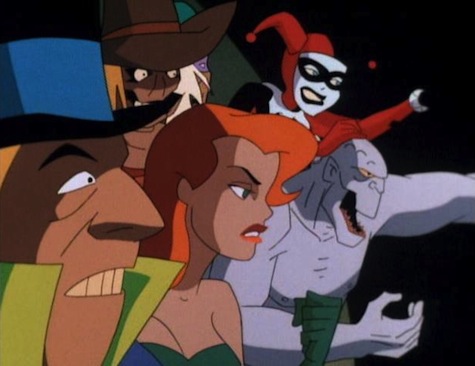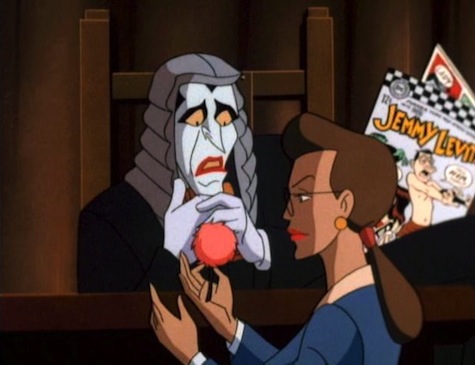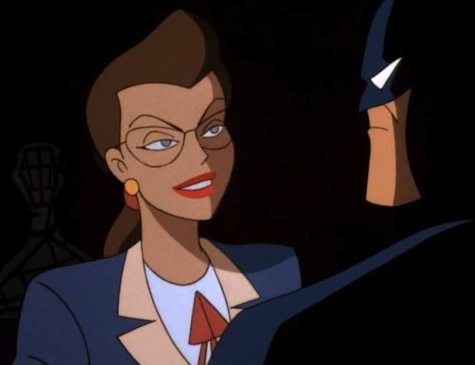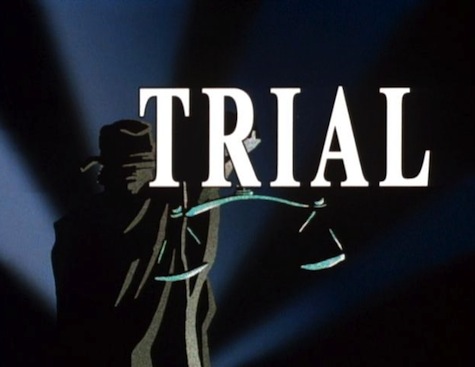“Trial”
Story by Paul Dini, Bruce W. Timm
Teleplay by Paul Dini
Directed by Dan Riba
Episode #068
Music by Harvey R. Cohen
Animation Services by Dong Yang Animation, Inc.
Original Airdate—May 16th, 1994
Plot: The inmates of Arkham Asylum force anti-Batman crusader Janet van Dorn to defend Batman against the charge that he created all of his enemies.
“Trial” started life as Paul Dini’s pitch for the Batman animated feature that eventually became Mask of the Phantasm: the lunatics take over the asylum and Batman has to fight them all. If that premise sounds familiar, it’s because Dini would reuse the heart of the story to great effect for the extremely popular Batman: Arkham Asylum video game, and even reuse Harley’s line describing the take over as “a little party.”
But in a half-hour format, the idea of Batman fighting all his foes at once is given short-shrift to focus on the titular trial of Batman. Bruce has doubted whether being Batman is the right way to honor his parents before, and Harvey Bullock’s been on Batman’s case since the “On Leather Wings,” but this is the first episode to take seriously the premise that Batman may be doing more harm than good.
The idea that Batman may be responsible for the creation of his own foes is certainly not unique to this episode. The theme of Christopher Nolan’s The Dark Knight is that—by weakening organized crime using dramatic tactics, and making the old gangsters desperate enough to look for any aid—Batman gives motivation, inspiration, and opportunity for new, worse criminals like the Joker to appear. And on a metafictional level, the argument is absolutely true: the villains were created specifically so Batman would have someone to fight. But that argument only truly works if you know that Batman and his foes are fictional characters.
But within the world of Batman, and especially within the continuity of Batman: the Animated Series, Batman’s enemies definitely would have become criminals whether or not Batman ever got involved. Even the Joker was a hitman before he fell into the vat of chemicals. The only villain you could possibly argue would not exist without Batman is Two-Face, and that’s only because Poison Ivy would have killed Harvey Dent long before his tragic accident.
“Trial” makes great use of the show’s actual continuity to prove that Batman cannot be held responsible for the behavior of his foes. When Janet van Dorn questions the Mad Hatter and Poison Ivy about how they took to crime, she might as well have sited episode title and production number (“Let that record show that in episode #27, ‘Mad as a Hatter,’ Mr. Tetch did knowingly and repeatedly….”). The punchline is that by the end, even Batman’s enemies have to admit that, yeah, it’s all their own fault!

As he did in “Almost Got ’Im,” Dini uses “Trial” to flesh out Batman’s rogues to hilarious effect. Minus the “sane” criminals Penguin, Catwoman, and Ra’s al Ghul, all of the other majors are here. The newly introduced Ventriloquist and Scarface are now canonically on par with the Joker, Two-Face, Poison Ivy, Harley Quinn, the Scarecrow, the Riddler, Killer Croc, and the Mad Hatter—and Scarface’s tommy gun does work. There’s the first animated mention of Harley Quinn’s origin as a former Arkham psychiatrist corrupted by the Joker (which had just been printed in The Batman Adventures: Mad Love two months before this episode aired). Croc’s go-to attack is still “hit him with a rock.” And the Riddler is out of his coma and in Arkham, or at least seems to be, but as he doesn’t actually say anything, or even move, maybe he’s not.
(Likewise, the Scarecrow doesn’t speak either, but that is because voice actor Henry Polic II was undergoing surgery when the episode was recorded, and the writers worked around that limitation by making the Scarecrow silent and spooky.)
And while Two-Face wants to just shoot/unmask Batman immediately, it’s clear that the other inmates are having a great time playacting a trial. There aren’t enough of them to even do it correctly, so the “jury” also have to be the witnesses and the bailiffs too. The Joker, who of course pretends to be the judge, realizes there should possibly be a court reporter only half-way into the proceedings, isn’t afraid to flirt with Harley on the stand, and distracts himself with a Go-Go-Checked DC Comic when other people are speaking. Even Batman’s “playing along,” if only to buy Gordon time to find them. Only the lawyers, former DA Harvey Dent and current DA Janet van Dorn, take the trial seriously, van Dorn going so far as putting on a brave face when the Hatter reads the verdict, even though she knows the whole thing is a farce.

Van Dorn is a great character, as it’s interesting to hear a rational argument against Batman from someone who isn’t self-interested. The fact that there’s a (Catwoman-like) love triangle, where van Dorn hates Batman but apparently dates Bruce Wayne, could create complicated interpersonal conflict. And Stephanie Zimbalist, star of Remington Steele and daughter of Efrem Zimbalist Jr. (aka Alfred), provides a perfect voice for a rational woman dropped into a deeply irrational world. Unfortunately, Janet’s never seen again.
The episode’s flaw is that van Dorn’s argument against Batman is two-fold: “Batman creates these so called ‘super criminals’” AND “he takes it upon himself to be their judge and jury with no regards to the legal system,” but the trial only addresses the first charge, which is absurd on the face of it. Meanwhile, the idea that masked vigilantism is a terrible way to fight crime is completely ignored, even though the episode establishes that it’s probably the more accurate charge.
We’ve seen Batman torture criminals, ransack offices without a warrant, and generally run roughshod over suspected criminals’ civil rights. Van Dorn calls Batman “a drug the city keeps taking to avoid reality,” and we’ve seen that over-reliance on Batman is a problem because if he’s incapacitated in any way, the entire city suffers. And not being in constant contact with the police has gotten Gordon shot. In “Trial” alone, Batman’s vigilantism costs van Dorn a conviction against Poison Ivy and wastes weeks of manpower when Batman brings in a gang leader on his own (one that looks suspiciously like The Punisher).
Batman the masked vigilante would make sense if Gotham were corrupt, but Animated Series Gotham just isn’t. The Police Commissioner is the most honest man in Gotham and the leading business man is the person most dedicated to justice. Mayor Hamilton Hill seems shady but the worst thing we’ve actually seen is that he was once photographed with an old mob boss. The only actively corrupt cop in Gotham was Lt. Gil Mason, who was quickly discovered and then beaten into a coma. In a Gotham as functional as the one presented, why can’t Batman be a ninja scientist detective who wears a badge instead of a mask?

Once the trial is over, however, we go back to Batman fighting his enemies with punches. At this point, Harvey Cohen’s fantastic score kicks in and we’re treated to some of the best dialogue in the series. (“Okay, start panicking.”) Unfortunately it seems that the Inverse Law of Ninja applies to Batman Rogues as well as Daleks. Each of these villains has given Batman an episode’s worth of grief on their own. Harley and Ivy, after all, easily overpower Batman (again). But get them all together and Batman starts tearing through them like a bull through wet paper. Partially, that’s because they get in each other’s way (the Scarecrow cuts off Scarface’s head, the Joker nearly shoots Croc and Harley) but mostly it’s because there’s only five minutes left in the episode and Batman doesn’t have time to spare. Once it gets down to the Joker, however, the episode becomes amazing. The Joker is literally playing judge and executioner, a parody of what van Dorn accused Batman of doing, and the “hanging” fight outside the Asylum is a wonderfully weird, visually dynamic, and satisfyingly intense “final boss fight” for the episode.
![]()
“Avatar”
Written by Michael Reaves
Directed by Kevin Altieri
Episode #069
Music Composed by Carlos Rodriguez
Animation by Studio Junio
Original Airdate—May 9th, 1994
Plot: Batman battles the earth-bending Clayface, while water-bender Poison Ivy… no, that’s not right.
Plot: Batman infiltrates a society of cat people who live in a giant tree and… no, that’s not it either.
Hold on, I got it this time.
Plot: Ra’s al Ghul returns to steal a priceless Egyptian scroll, and Batman teams up with Talia to track her father down before Ra’s finds a tomb housing an ancient power and an unspeakable evil.
While Indiana Jones was one of many influences on “The Demon’s Quest,” “Avatar” is entirely an homage to the adventures of Henry Jones Jr. From the opening, silent prologue of an archeological dig gone horrifically wrong (featuring an amazing score by Carlos Rodriguez) to Ra’s robbing a museum by throwing a snake at Batman (of course Batman has anti-cobra venom in his belt) to traveling to Europe by map, to the Arabic stereotype vendor who is actually selling Chinese imports as Egyptian relics.
![]()
Following the homage to its logical conclusion leads Reaves and Altieri to break one of the unwritten rules of Batman: the Animated Series and feature honest-to-goodness magic. So far the series has taken great pains to avoid the supernatural, depowering Zatanna and using science fiction to explain werewolves, invisible men, and rampaging mud monsters. But Raiders of the Lost Ark ends with angels melting the faces off of Nazis (spoilers?), so “Avatar” ends with Ra’s meeting a three thousand year old sorceress, and all the Lazarus Pits in the world can’t explain how Thoth Khepera (voiced by Nichelle Nichols!) is still alive, let alone a vampire mummy earthbender. The only explanation is “magic,” something Batman cannot fight, explain, or even describe properly. (The best Bruce can manage is “that… thing.”)
Including magic is one way in which the creators expand what the series can do in these later episodes. Another way is Bruce’s wardrobe. For the first sixty five episodes, it appeared the only outfit billionaire Bruce Wayne owned was a hideous brown suit. But Bruce spends so much of “Avatar” in his civilian identity that we get to see a few different outfits, a dark suit when he’s playing the callous rich boy with Lucius Fox, a white suit when visiting an old girlfriend, and the lovely blue shirt and jodhpurs number he sports while antiquing. Actually, Talia and Ra’s also wear jodhpurs in the episode. Maybe a better title would have been “Everybody Loves Jodhpurs.”
![]()
Of course, under the pulp adventures and anachronistic sartorial choices, “Avatar” is one of the more emotionally complicated episodes of the series. From the opening title card, “Avatar” is about Ra’s and Talia’s conflicted relationship and it serves as Talia’s recidivism episode. Unlike Croc or the Penguin, however, Talia does not revert to a life of crime out of greed or revenge, but out of loyalty to her father. She simply cannot let her father go to jail, and will do everything in her power to save him.
Complicating her loyalty is that, by the end of the episode, Talia knows that her father will not be deterred from his plan to kill billions, that Ra’s has practically disowned her, chauvinistically believing a woman could never be his true heir, and that Ra’s has tried to kill her. And yet, even though Ra’s cannot be saved, even though Ra’s does not want to be saved, and even though, by helping Ra’s, she damns herself, Talia cannot abandon her father.
It helps that this is Helen Slater’s best performance and the best Talia’s been written in the series so far. Far from the Bond-girl femme fatale of “Off Balance,” or the harem princess of “The Demon’s Quest,” this Talia is a three dimensional character who is honestly caught between her love for her father and her love for Batman. She’s a capable fighter who’s never needs to be rescued (unlike her father) and she makes her own decisions for herself. That’s why it’s that much worse when she betrays Batman at the end. It wasn’t her plan all along, but rather a painful decision she comes to at that moment. “Though it breaks my heart, I will do what I must,” Talia says. Talia is aware that no matter what choice she makes, she will lose.
![]()
Unfortunately, the strength of Talia as a character comes at the expense of Ra’s al Ghul, who acts like an immature idiot for an episode. He’s very quick to feel betrayed by Talia and Batman and attacks them out of spite, which is behavior unbecoming a 700 year old. Talia thought he was dead. It was on Ra’s to correct that misconception. He’s also quick to make out with a sorcerous lady in a room covered in skeletons. And dumbest of all, Ra’s repeats Kyodai Ken’s mistake of trying to pick up an ancient scroll, only for it to crumble in his hands, over and over. You are the worst archeologist, Ra’s al Ghul. The worst.
Strangely, as all the relationships between Batman, Talia, and Ra’s al Ghul all fall apart, Batman finds an unexpected connection with Ubu, Ra’s right hand man. By the end of “The Demon’s Quest,” these two men hated each other, and Ubu’s only line in “Avatar” is to once again insult Batman by calling him “infidel.” But after Batman saves Ubu from the collapsing temple, because Batman saves everyone, Ubu repays the favor by dropping a water canteen and utility belt for Batman to use. These two men will never like each other, but maybe they can respect each other.
Steven Padnick is a freelance writer and editor. By day. You can find more of his writing and funny pictures at padnick.tumblr.com.










